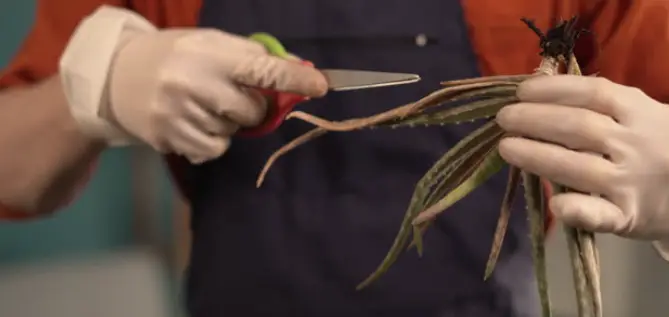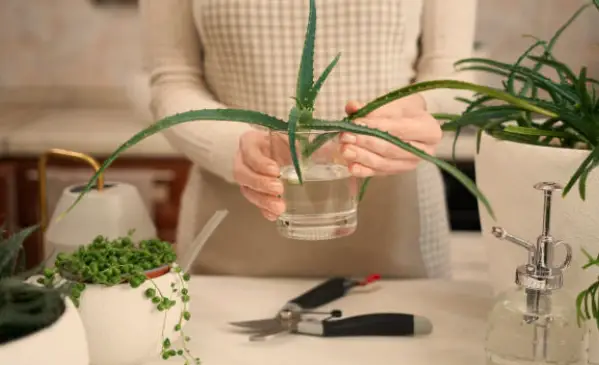Aloe Plant Cut: The Succulent That Keeps on Giving

One of the most adaptable and resilient succulents available is the aloe vera plant. Aloe is a plant with thick, spiky leaves that release a gel-like liquid. It has been used for generations as a home cure for cuts, burns, and irritation of the skin.
However, many people are unaware that an aloe plant can continue to grow and produce more of that calming gel for years after parts of its leaves are removed.
If you have ever cut into an aloe leaf to extract the sticky center for a DIY facial, you might be wondering what becomes of the plant afterward. Will chopping off a leaf, or a portion of it, result in irreversible harm? Can an aloe plant that has been cut in this way live and grow again?
The good news is that an aloe plant can completely recover from having parts removed because of its succulent nature and remarkable resilience. In fact, with the right care, your aloe can develop new leaves to replace the old ones you cut away.
Aloe’s Growth Habits

Knowing how aloes grow and regenerate can help you take good care of them once you cut them. Being succulents, aloe veras retain a lot of water and nutrients in their thick leaves, which helps them endure dry spells.
Because it contains so many vitamins, minerals, amino acids, and antioxidants, the sap found inside the leaves is extremely beneficial to humans.
Each single aloe plant can live for many years, slowly growing new leaves from its central stem to replace the old outer leaves that eventually dry up and die off naturally. You may have noticed brown, shriveled-up leaves around the bottom of a mature aloe plant; this is normal sloughing as part of the growth cycle.
As long as the main stem and root system are healthy, a loss of just a few leaves won’t permanently damage or kill an aloe.
Removing Leaves Properly
When harvesting aloe gel from your plant, it’s best to remove entire leaves cleanly rather than simply slicing off part of a leaf. Use a sharp knife and cut as close as possible to the base where the leaf meets the stem. Leaving half a leaf behind creates an open wound that is more susceptible to infection.

You’ll also want to avoid breaking or tearing the leaves, as ragged cuts can impair the plant’s ability to seal up and callous over properly. Take off only the number of outer leaves you need, being careful not to remove too many at once from a single aloe plant. Leave the top quarter of the innermost, youngest leaves intact.
Aftercare for Cut Aloe Plants
Once you’ve carefully cut away the leaves you need, there are a few simple steps to follow for helping your aloe vera recover:

Let it Rest
After cutting, leave the aloe plant alone for at least a week or two with no further disruptions. This gives it time to start closing up and healing over the cut areas before you water it again or move it around.
Withhold Water
Don’t water an aloe for 7–10 days after cutting its leaves. The remaining raw, open areas need to thoroughly dry out and callous over first before introducing more moisture that could lead to rotting.
Increase Air Flow
Good air circulation helps dry out the cut surfaces faster and discourages bacterial growth. If possible, use a small fan or place your aloe plant near an open window for better air flow while it recovers.
Remove Any Rot
Check on your aloe periodically and use a clean utensil to remove any discolored or mushy tissue you see forming at the cut sites. Stop any rot in its tracks before it can spread.
Once new growth emerges from the stem and the cuts have sealed up fully with calloused areas, you can resume normal watering and care for your aloe. Under the right conditions, new offsets and pups may form at the base, creating an even fuller plant over time.
Within several months, your aloe should have regenerated brand new leaves from the center to replace the old ones you harvested. Be patient, and before you know it, you’ll have a lush, healthy aloe vera plant once again, ready to provide more soothing gel the next time you need it.
Tips for Long-Term Aloe Maintenance After Cutting
While aloe veras are resilient and can bounce back after having pieces removed, they still require appropriate care to truly thrive long-term. Follow these guidelines for keeping your rehabilitated aloe plant in top shape:

The Right Pot
Aloes do best in a pot or container with good drainage holes to prevent soil from becoming saturated. Terracotta is an ideal material, as it allows airflow to the roots. Make sure your pot has enough room to accommodate future growth.
Well-Draining Soil
These succulents hate sitting in wet soil, that can lead to rot. Potting mixes specifically for cacti and succulents combined with perlite, coarse sand, or small rocks will ensure fast drainage.
Bright, Indirect Light
Aloe veras need at least six hours of bright, sunny light per day, but direct afternoon sun can scorch their leaves. East or west-facing window locations are ideal, or supplement with a grow light.
Proper Watering
The number one killer of aloe plants is overwatering. Only water your aloe when the soil is completely dried out, giving it a deep soak and allowing it to drain completely. Cut back to monthly waterings in winter.
Ideal Temperatures
These tropicals do best in warm environments around 70–80°F during the day and no lower than 50–55°F at night. Adjust watering down in winter when dormant.
Annual Repotting
Aloes can stay pretty root-bound, but repot once a year in early spring to refresh the soil and give it room to grow.
A single aloe plant can grow into an amazingly enormous and full specimen for decades, provided the proper circumstances are met and the leaves are occasionally harvested for usage. Remind yourself that a little maintenance goes a long way in keeping your aloe healthy and prolific for many more years to come the next time you find yourself reaching for the sharp knife to take another cutting.






